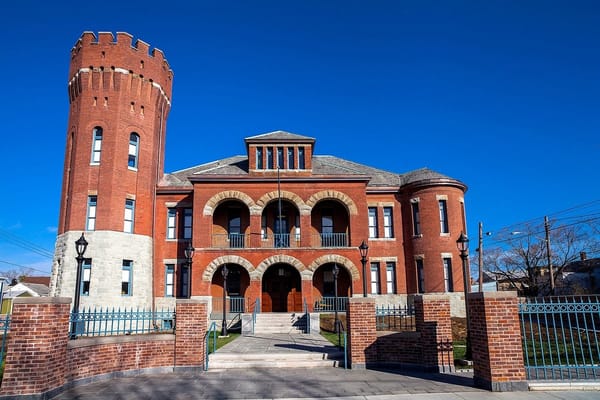Bard CFO Sheds Light on Major Hudson Property Gift from Controversial Developer
The Galvan Foundation's gift includes the Hudson Area Library and many other major Hudson structures.

The Galvan Foundation's gift includes the Hudson Area Library and many other major Hudson structures.

The Hudson Area Library.
Bard College is currently undergoing a 90-day due diligence process to evaluate a major gift to its endowment of dozens of properties in the City of Hudson—a portfolio of commercial, residential, and public-use buildings (including the Hudson Area Library) amassed by the Galvan Foundation over the past 20 years.
The prospective donation, announced earlier this month, would significantly expand Bard’s real estate holdings, in a municipality nearly 30 minutes from its campus. But as the college proceeds with its internal review, local stakeholders are already raising questions about transparency, the future of current tenants, and the long-term impact on Hudson’s already complex housing and development dynamics.
According to Bard Chief Financial Officer Taun Toay, the college is approaching the opportunity with a clear-eyed awareness of its scale and sensitivity. While much is currently undecided, he addressed two early concerns voiced by the public: Bard will not be using Hudson properties for student housing, and has already reached out to the library board to set up discussions on its wants and needs.

A property on Allen Street renovated and sold by Galvan in 2024.
“This is quite a bit different than any of Bard’s other property acquisitions,” Toay says, contrasting it with previous gifts or purchases like the Messina campus, which was contiguous to existing Bard land and quickly integrated into academic use. “I don’t think that we’re intending to use any of these properties for college purposes, or at least beyond partnerships with existing tenant organizations, or work that we would do that’s more in the line of civic engagement and community education.”
Toay emphasized that any speculation about the college planning to turn properties into student housing is unfounded. “Nothing like that is on the table,” he says, clarifying that the buildings under consideration are “not buildings conducive to dormitories.” Bard is currently completing a major new on-campus housing project this summer. Toay notes, “I’m opening 430 beds in two weeks.”
While there are a lot of community questions surrounding the property transfer, some Hudsonians have voiced optimism about the city moving on from its historically tumultuous relationship with the Galvan Foundation and real estate investor T. Eric Galloway, who founded the organization with his late partner Henry van Ameringen. With more than 80 properties at its peak, Galvan is the city’s largest landowner.
Galvan has completed notable projects, including the restoration of the Hudson Armory into a library and senior center, the creation of affordable and supportive housing, and the renovation of community spaces. But many residents have questioned the foundation’s approach. Critics point to long-vacant properties and limited public communication on major changes to, and even removal of, historic structures. Some city officials have described Galvan’s behavior as “warehousing” property and criticized a lack of transparency in decision-making. Concerns have also persisted about Galloway’s outsized influence on city politics. Some residents have recently taken issue with the fact that Mayor Kamal Johnson lives in a home owned by Galvan and has not disclosed his rent.
The Galvan portfolio—estimated to be worth “tens of millions” according to Toay—is still being appraised. The college does not yet own any of the buildings, and the final list of properties to be transferred has not been finalized. “The announcement was made on the gift—that’s an intended transfer of ownership, not a done deal,” he says.
For now, Bard is getting in touch with tenants, including the library. “We’ll be meeting with the library board,” Toay says, adding that if the city were interested in acquiring the property, Bard would be open to that. “We’re not going to be running it as a Bard library.”
As Bard proceeds, it must weigh which properties might be held for long-term capital preservation and which could be sold. “We’ll be looking to sell a number of properties,” Toay says. “We’ll be looking to probably hold a few others, and it’s going to be a several-month process to determine which falls where.”

Inside the Hudson Area Library
When asked about community engagement, Toay acknowledged the scrutiny that Galvan has faced in Hudson over the years—particularly around transparency. “We’re a different kind of nonprofit,” he says. “We have a different relationship to Hudson and one that’s all education first. We’ll see how much it ultimately settles out at, but I certainly would appreciate kind of quelling the rumor mill, on the issue of student housing in particular.”
As for broader public concerns about the local housing market, Toay says, “I also know there’s a housing shortage in Hudson, and that’s a policy emphasis for a lot of people up there. And so we’ll be very mindful of that as we navigate what we do.”
“It’s hard to telescope what you do and don’t want to sell,” Toay adds. “Our financial interest in this is one of long-term capital preservation for the college. Once we’re ready to do the actual property transfer, we would have a press release associated with that. That would be the final list of properties, that would be where we would ascribe value and point the way for some of our plans.”
For now, Hudson residents and stakeholders are left to wait for that final list—and hope that Bard’s stated intentions of civic engagement and transparency mark a shift from the ambiguity that’s often surrounded the properties’ previous ownership.